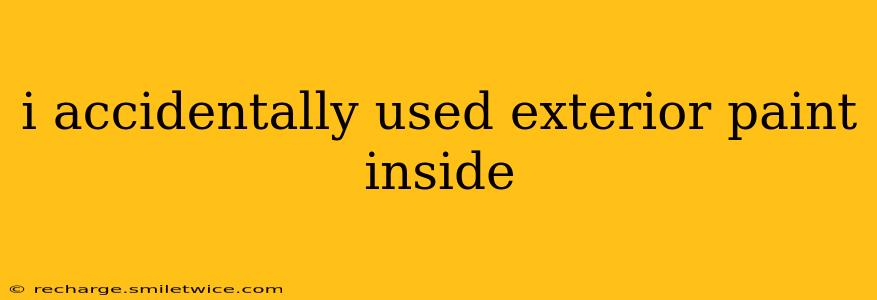Using exterior paint indoors is a common mistake, but the consequences can be significant. Exterior paints often contain higher levels of volatile organic compounds (VOCs) than interior paints, posing health risks and potentially damaging your home's interior. This guide will help you understand the implications and what steps to take to mitigate the problem.
What are the dangers of using exterior paint inside?
Exterior paints are formulated to withstand harsh weather conditions, requiring stronger, more durable ingredients. This often translates to higher VOC content. VOCs are organic chemicals that evaporate easily at room temperature, releasing harmful fumes into the air. Breathing these fumes can cause a range of symptoms, from headaches and nausea to more serious respiratory problems. Moreover, some exterior paints contain ingredients that are not designed for indoor use and may release harmful substances over time.
What are the symptoms of VOC exposure?
Exposure to high levels of VOCs can manifest in several ways:
- Eye, nose, and throat irritation: Burning sensations in these areas are common.
- Headaches: Frequent or persistent headaches can be a sign of VOC exposure.
- Nausea: Feeling sick to your stomach is another potential symptom.
- Dizziness: Feeling lightheaded or unsteady is also a possible sign.
- Fatigue: Persistent tiredness can be indicative of VOC exposure.
- Skin irritation: Some individuals may experience rashes or other skin problems.
If you experience any of these symptoms, get fresh air immediately and consult a doctor.
How long does it take for exterior paint fumes to dissipate?
The time it takes for exterior paint fumes to dissipate depends on several factors:
- The type of paint: Paints with higher VOC levels will take longer to dissipate.
- The amount of paint used: Larger areas painted will obviously release more fumes.
- Ventilation: Good ventilation significantly speeds up the process.
In general, you should expect it to take several days or even weeks for the fumes to significantly reduce, especially with poor ventilation. Opening windows and using fans can greatly accelerate the dissipation process.
Can I just leave it and hope it's fine?
No. Leaving the paint as is poses significant health risks, especially for sensitive individuals like children, the elderly, and those with respiratory conditions. The potential long-term health effects of prolonged exposure to high VOCs outweigh any short-term inconvenience of remediation.
What should I do to fix the problem?
The best course of action depends on the extent of the application. If it’s a small area, removing the paint may be feasible. For larger areas, you will need to apply a sealant, allowing time to air out before repainting with an interior-grade paint formulated for your surface. Consider professional help if the situation seems overwhelming.
Should I use a primer before repainting with interior paint?
Yes. Applying a primer designed for interior use will help ensure the new interior paint adheres properly and prevents the exterior paint's color or texture from showing through.
What kind of interior paint should I use over exterior paint?
Choose a high-quality, low-VOC interior paint that's suitable for the surface you've painted. Always check the paint label for VOC content and other relevant information.
Addressing this mistake promptly and thoroughly is crucial to protect your health and the well-being of your household. Prioritize ventilation and consider professional help if you're uncertain about the best course of action. Remember, preventing future mistakes is just as important; always double-check your paint selection before starting any project.
